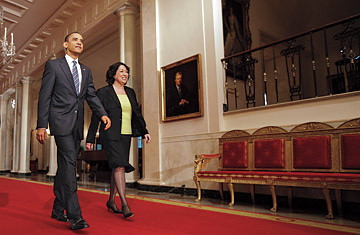
The President with Sotomayor, the first Hispanic female to be nominated to the U.S. Supreme Court.
(2 of 6)
By 1972, Sotomayor had moved on to Princeton, where she studied history. She once said that when she got there, she felt like a "visitor landing in an alien country." But she left with highest honors and a Phi Beta Kappa key. From there, she went on to law school at Yale, where she was an editor of the Yale Law Journal. By that time, she was also married to a high school sweetheart, Kevin Edward Noonan--a marriage that ended in divorce in 1983.
At Yale, Sotomayor never took her foot off the pedal. "She was something of a grind," says Stephen Carter, a classmate and friend who now teaches at Yale. "She was always in the library, always had a casebook under her arm." But unlike some of the hardest-charging young law students, says Carter, "she always had a manner that was open. She didn't put down other people." Even then, her approach to the law was meticulous and small bore, as in a piece she published in the law journal on a technical issue affecting potential Puerto Rican statehood. "She wasn't advocating for or against a particular position on statehood," says Martha Minow, a colleague at the journal who now teaches at Harvard Law School. "She was carefully parsing out the legal questions."
After law school, Sotomayor worked for five years in the office of Manhattan district attorney Robert Morgenthau, where she prosecuted everything from petty drug crimes to felony assaults and murder. No less than her background in the projects, her experience pressing criminal cases may have affected her outlook years later on the bench. One case she presided over, U.S. v. Falso, seemed likely to go against police who had charged a man with possessing child pornography after they entered his house on a wrongly issued search warrant. Instead, Sotomayor ruled in favor of the officers. "It wasn't just a pro-prosecutor bias," says Carter. "It was her understanding of the practical problems of being a police officer."
Sotomayor left Morgenthau's office in 1984 to move into private practice as an attorney with a firm specializing in business cases. When George H.W. Bush was looking for nominees to the federal district court in the Southern District of New York, it was a Democrat, New York Senator Daniel Moynihan, who recommended her. She was easily confirmed, but in 1997, when Bill Clinton decided to move her up to the appeals court, Republicans held off a confirmation vote for more than a year, fearing that she was being fast-tracked to be Clinton's next Supreme Court nominee.
More than a decade later, her appointment has finally arrived, and it couldn't come at a more difficult moment for her opponents. For now, the GOP strategy for dealing with Sotomayor is to walk softly and carry a big magnifying glass, searching for a potentially explosive opinion buried somewhere in her roughly 400 rulings from the federal bench. Republicans have their work cut out for them. The Second Circuit Court of Appeals hears plenty of cases involving business and securities law but not many that touch on the hot-button issues that make for good attack ads. Abortion, the death penalty, gay rights, executive power--those haven't come up much, if at all, on Sotomayor's docket. The White House says its nominee has been fully researched, but Republicans are pinning their hopes on the fact that the Obama Administration has had a somewhat spotty vetting record.
The New Haven Case
